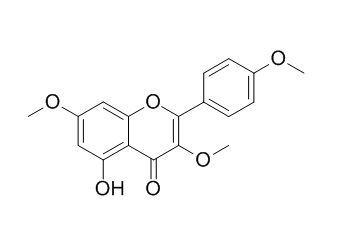Kaempferol 3,7,4'-trimethylether
Kaempferol 3,7,4'-trimethylether shows selective cyctoxic activities against the nine tested cancer cell lines.
Inquire / Order:
manager@chemfaces.com
Technical Inquiries:
service@chemfaces.com
Tel:
+86-27-84237783
Fax:
+86-27-84254680
Address:
1 Building, No. 83, CheCheng Rd., Wuhan Economic and Technological Development Zone, Wuhan, Hubei 430056, PRC
Providing storage is as stated on the product vial and the vial is kept tightly sealed, the product can be stored for up to
24 months(2-8C).
Wherever possible, you should prepare and use solutions on the same day. However, if you need to make up stock solutions in advance, we recommend that you store the solution as aliquots in tightly sealed vials at -20C. Generally, these will be useable for up to two weeks. Before use, and prior to opening the vial we recommend that you allow your product to equilibrate to room temperature for at least 1 hour.
Need more advice on solubility, usage and handling? Please email to: service@chemfaces.com
The packaging of the product may have turned upside down during transportation, resulting in the natural compounds adhering to the neck or cap of the vial. take the vial out of its packaging and gently shake to let the compounds fall to the bottom of the vial. for liquid products, centrifuge at 200-500 RPM to gather the liquid at the bottom of the vial. try to avoid loss or contamination during handling.
Sustainability2021, 13(23),12981.
J Microbiol Biotechnol.2023, 33(10):1317-1328.
US20170000760 A12016, 42740
The Thai Journal of Pharmaceutical Sciences2023, 47(3):3.
J Biochem Mol Toxicol.2025, 39(8):e70416.
Dent Mater J.2020, 39(4):690-695
International J of Green Pharmacy2019, 13(3)
Pharmaceutics.2022, 14(5):945.
J of Archaeological Science:Reports2024, 53:104298
J. of Agricultural Science2015, 1916-9760
Related and Featured Products
BMC Complement Altern Med. 2014 Sep 19;14:340.
Cytotoxicity of four Aframomum species (A. arundinaceum, A. alboviolaceum, A. kayserianum and A. polyanthum) towards multi-factorial drug resistant cancer cell lines.[Pubmed:
25239700 ]
The search for natural products as potential cytotoxic agents has yielded promising candidates. However multidrug resistance (MDR) is still a major hurdle for patients receiving chemotherapy. In the present study, we evaluated the cytotoxicity of the methanol extracts of four dietary Aframomum plant species (A. arundinaceum, A. alboviolaceum, A. kayserianum and A. polyanthum) against nine sensitive and MDR cancer cell lines. We have also identified the bioactive constituents of A. arundinaceum.
METHODS AND RESULTS:
The cytotoxicity of the methanol extracts of the above plants was determined using a resazurin reduction assay. Chromatographic techniques were used to isolate the constituents of A. arundinaceum.
A preliminary experiment on leukemia CCRF-CEM cells at 40 μg/mL showed that the extracts from A. kayserianum and A. alboviolaceum as well as the isolated compounds namely compounds aframodial (1), 8(17),12-labdadien-15,16-dial (2), galanolactone (3), 1-p-menthene-3,6-diol (6) and 1,4-dimethoxybenzene (7) were less active, inducing more than 50% growth of this cell line contrary to A. polyanthum and A. arundinaceum extracts, galanals A (4) and B (5), naringenin (8) and Kaempferol 3,7,4'-trimethylether (9). The IC50 values below or around 30 μg/mL were recorded with A. arundinaceum extract against eight of the nine tested cancer cell lines. This extract as well as compound 8 displayed IC50 values below 40 μg/mL towards the nine tested cancer cell lines whilst A. polyanthum extract, compounds 4, 5 and 9 showed selective activities. Collateral sensitivity (hypersensitivity) was observed with A. arundinaceum extract towards leukemia CEM/ADR5000 cells and glioblastoma U87MG.ΔEGFR compared to their respective sensitive counterparts CEM/CEM and U87MG.
CONCLUSIONS:
The results of this study provide evidence of the cytotoxicity selected Aframomum species as well as a baseline information for the potential use of Aframomum arundinaceum in the fight against drug sensitive and otherwise drug-resistant cancers.
Songklanakarin Journal of Science and Technology, 2013, 35,(3): 317-23.
Inhibition of nitric oxide production by compounds from Boesenbergia longiflora using lipopolysaccharide-stimulated RAW264.7 macrophage cells[Reference:
WebLink]
METHODS AND RESULTS:
The inhibitory activity of extract and compounds isolated from Boesenbergia longiflora against nitric oxide (NO) was evaluated using RAW264.7 cells. Isolation of the chloroform extract of B. longiflora rhizomes afforded four known flavonoids, which were identified as Kaempferol 3,7,4'-trimethylether (1), kaempferol-7,4'-dimethyl ether (2), rhamnazin (3), pinostrobin (4), together with four known diarylheptanoids, dihydrobisdemethoxycurcumin (5), curcumin (6), demethoxycurcumin (7) and bisdemethoxycurcumin (8), as well as one sterol, -sitosterol-D-glucoside (9). Compound 6 exhibited the highest inhibitory activity against NO release with an IC50 value of 4.5 μM, followed by 7 (IC50 = 11.7 μM), 8 (IC50 = 15.7 μM), 5 (IC50 = 23.0 μM) and 1 (IC50 = 23.5 μM), respectively.
CONCLUSIONS:
This study demonstrated that diarylheptanoids and some methoxyflavonoids found in B. longiflora are responsible for anti-inflammatory activity and this is the first report the safety, chemical constituents and biological activity of this plant.



